Physical Address
304 North Cardinal St.
Dorchester Center, MA 02124
The kidneys are paired retroperitoneal organs that lie lateral to the upper lumbar vertebrae. In the relaxed, supine position, their superior poles are level with the twelfth thoracic vertebra, while their inferior poles are level with the third lumbar vertebra and about 2.5 cm superior to the iliac crest. On deep inspiration in the erect position, however, both kidneys may descend near or even past the iliac crest. Usually the right kidney lies 1 to 2 cm inferior to the left kidney because its developmental ascent is blocked by the liver.
Most commonly, both kidneys are surrounded by a variable amount of retroperitoneal fat (see Plate 1-5 ); as in most anatomic descriptions, however, this fat is not considered in the relational descriptions that follow.
Both kidneys lie in close proximity to the abdominal aorta and inferior vena cava. These major vessels extend branches to each kidney that enter at a notched, medially located area of the parenchyma known as the hilum. At the level of the kidneys, the abdominal aorta lies directly anterior to the vertebral column, passing about 2.5 cm anteromedial to the left kidney. The inferior vena cava lies to the right of the aorta, nearly touching the medial aspect of the right kidney. Both kidneys are rotated so that their medial surfaces are slightly anterior, facilitating their connection to these major vessels.
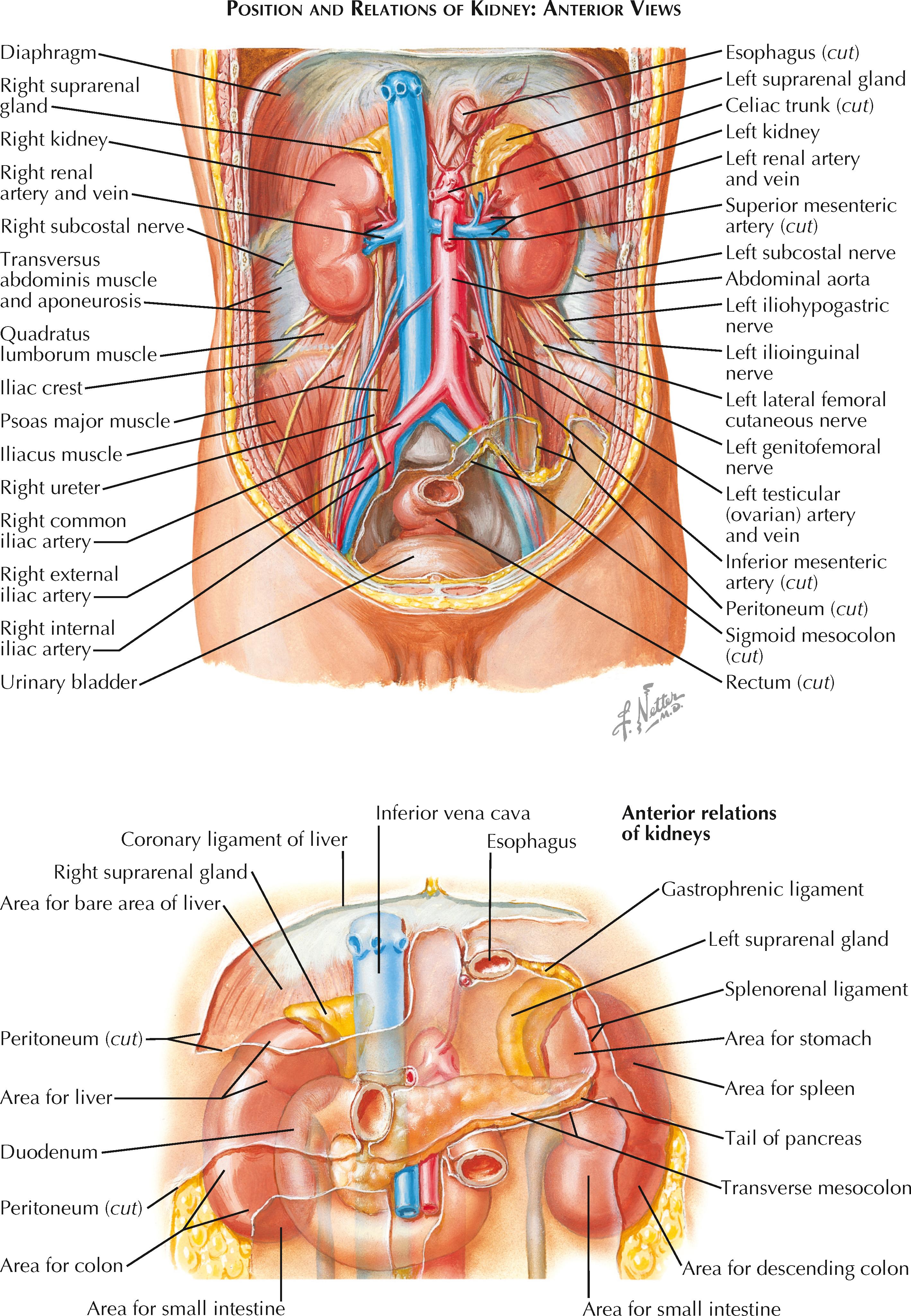
The suprarenal glands, historically referred to as “adrenal” (a misnomer that incorrectly implied a subservient relationship to the kidneys), are bilateral glands typically related to the superomedial aspects of the kidneys but not attached to them. They are attached to the diaphragmatic crura, a relationship maintained in the presence of nephroptosis (“dropped kidneys”). Like the kidneys, the suprarenal glands are surrounded by a variable amount of fat. The crescentic left suprarenal gland lies medial to the upper third of the kidney, extending from the apex to the hilum. The pyramidal right suprarenal gland sits caplike on the superior pole of the right kidney.
The anterior relations of the left and right kidneys differ, reflecting their associations with the various unpaired organs that constitute the abdominal viscera. The posterior relations of both kidneys are similar, reflecting their associations with the paired muscles of the posterior abdominal wall.
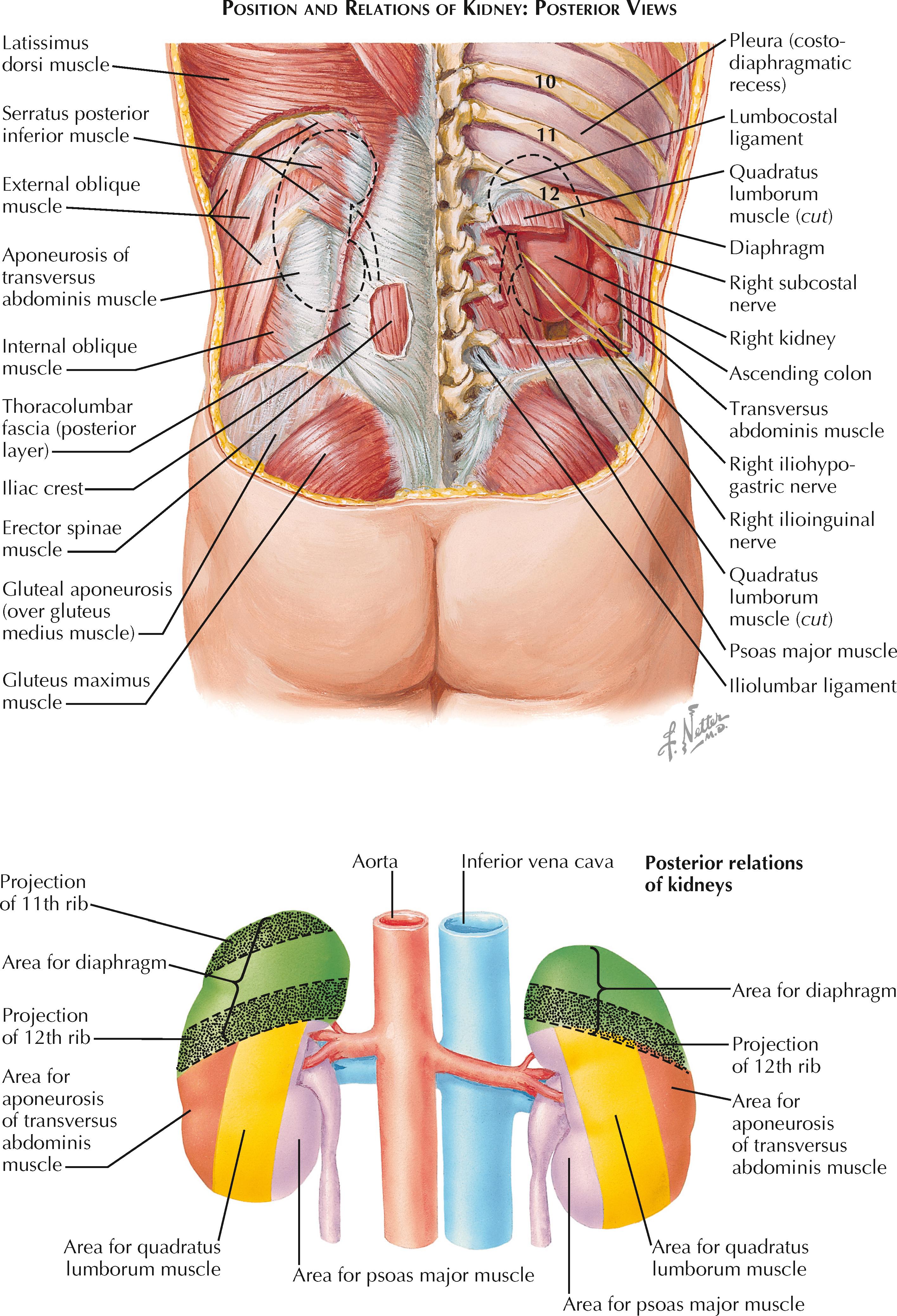
Kidney development occurs in the retroperitoneal space on each side of a dorsal mesentery, which is initially attached along the midline of the posterior body wall. During growth of the liver and rotation of the gut, certain portions of the gut fuse to the posterior body wall and become secondarily retroperitoneal. Throughout this process, peritoneal reflections are shifted from the midline and distorted in an irregular but predictable pattern.
After development is complete, certain parts of the kidneys contact intraperitoneal organs through an intervening layer of peritoneum, whereas other parts contact primarily or secondarily retroperitoneal organs without an intervening layer of peritoneum. The presence or absence of intervening peritoneum may affect the spread of infection or metastatic disease.
The superolateral aspect of the left kidney contacts the spleen. Separating these organs is the peritoneum that forms the posterior surface of the perisplenic region of the greater peritoneal sac. A triangular area on the superomedial aspect of the left kidney contacts the stomach. Separating these organs is the peritoneum of the lesser sac (omental bursa). The splenic and gastric areas of the anterior renal surface are separated by the splenorenal ligament, a derivative of the dorsal mesentery that forms the left boundary of the lesser sac. The two layers of the peritoneum that form the splenorenal ligament enclose the splenic vessels.
The perihilar region of the left kidney contacts the tail of the pancreas, a secondary retroperitoneal organ, without intervening peritoneum. This point of contact occurs posterior to the left extremity of the transverse mesocolon, a horizontally disposed derivative of the embryonic dorsal mesentery that suspends the transverse colon from the secondarily retroperitoneal viscera (i.e., duodenum and pancreas).
The inferolateral aspect of the left kidney contacts the descending colon, which is secondarily retro peritoneal, without intervening peritoneum. The inferomedial aspect of the left kidney contacts loops of jejunum through an intervening layer of inframesocolic peritoneum.
The upper two thirds of the right kidney contact the right lobe of the liver. The superior pole extends above the coronary ligament to directly contact the bare area of the liver without intervening peritoneum. Inferior to the pole, the kidney is covered with peritoneum that forms the posterior wall of the hepatorenal recess (also known as the Morison pouch), part of the subhepatic space of the greater peritoneal sac.
The perihilar region of the right kidney directly contacts the second (descending) part of the duodenum, which is secondarily retroperitoneal.
Most of the lower third of the right kidney is in direct contact with the right colic flexure; however, a small section of the inferior pole may contact the small intestine through a layer of inframesocolic peritoneum.
The approximate upper third of both kidneys contacts the diaphragm. The diaphragm normally separates the kidneys from the diaphragmatic part of the parietal pleura. On occasion, however, a deficiency in the region of the lateral arcuate ligament or the lumbocostal trigone allows one of the kidneys to directly contact the overlying diaphragmatic pleura.
The upper third of the left kidney lies anterior to, and is thus protected by, the eleventh and twelfth left ribs. A smaller portion of the right kidney receives similar protection in its relationship to right twelfth rib.
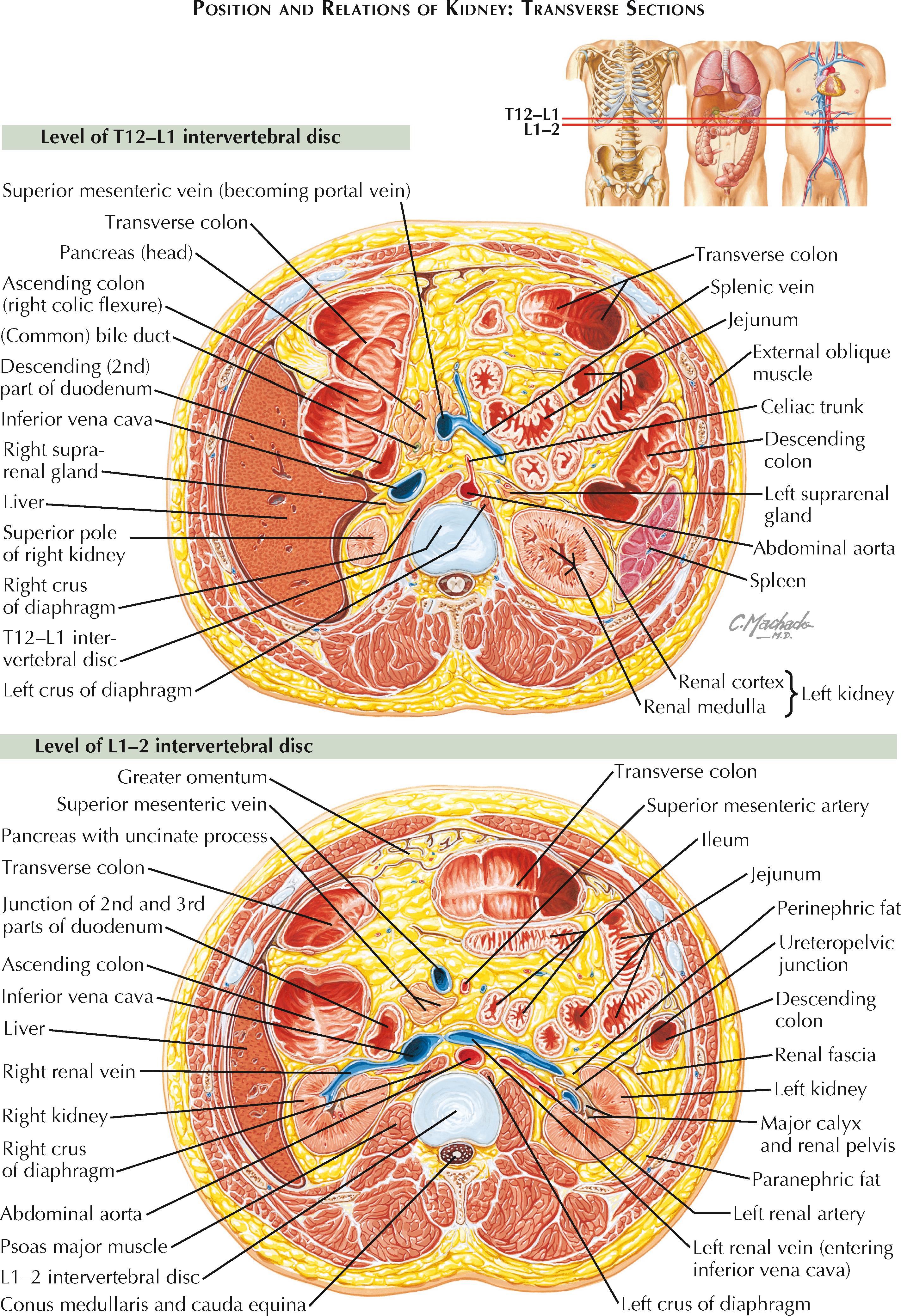
With regard to the lower two thirds of both kidneys, the lateral aspects rest on the aponeuroses of the transversus abdominis muscles; the central aspects rest on the quadratus lumborum muscles; and the medial aspects rest on the psoas muscles.
The psoas muscles take an oblique course from the lumbar vertebrae to the femurs, displacing the kidneys laterally. Because the right kidney lies inferior to the left kidney, it is generally displaced farther from the midline.
On each side, two or three nerves pass posterior to the psoas muscle, emerge from its lateral border, then travel between the kidneys and the aponeurosis of the transverse abdominis as they descend obliquely to the inguinal region. In craniocaudal order, these are the subcostal (T12 spinal) nerve and the L1 spinal nerve or its terminal branches—the iliohypogastric and the ilioinguinal nerves.
The adult kidney is about 11 cm long, 2.5 cm thick, 5 cm wide, and weighs between 120 and 170 g. The lateral border of each kidney is convex, whereas the medial border is concave. The superior and inferior poles are rounded. Both the anterior and posterior surfaces of the kidney are also convex, although the posterior surface may be relatively flattened.
The renal artery and vein, as well as the urine collecting system, enter and exit the medial aspect of each kidney at the hilum. This indented region leads to a spacious cavity within each kidney known as the renal sinus. Within the renal sinus, a matrix of perinephric fat surrounds branches of the renal artery and vein, as well as the large branches of the urinary collecting system. The veins are generally the most anterior and the branches of the collecting system most posterior, with the arteries coursing in between.
The entire outer rim of the renal parenchyma consists of a brownish pink region known as the renal cortex. Deep to the cortex, numerous darker-colored renal pyramids, with bases directed peripherally and apices directed centrally, collectively form the renal medulla. The apices of the renal pyramids are known as the renal papillae. Two or more pyramids may fuse at their papillae; thus there are more pyramids than papillae in each kidney.
The areas of cortex overlying the bases of the pyramids, separating them from the outer surface of the kidney, are known as cortical arches. The areas of cortex projecting between pyramids are known as renal (cortical) columns (of Bertin). The term “column” refers to their appearance on section; in fact, they are more like walls, which surround and separate the pyramids.
Although the borders between pyramids and renal columns are sharply defined, the pyramids project striations into the cortical arches, known as medullary rays. These striations largely represent collecting ducts (see Plate 1-26 ), which extend from the cortex to the renal papillae, merging along the way into papillary ducts. The papillary ducts drain urine to 20 or more small pores at each papilla's cribriform area (area cribrosa). One to three papillae drain into each minor calyx; two to four minor calices join to form a major calyx; and two or three major calices join to form the funnel-shaped renal pelvis, which becomes the ureter after leaving the hilum. The ureter, in turn, conveys urine to the bladder for storage.
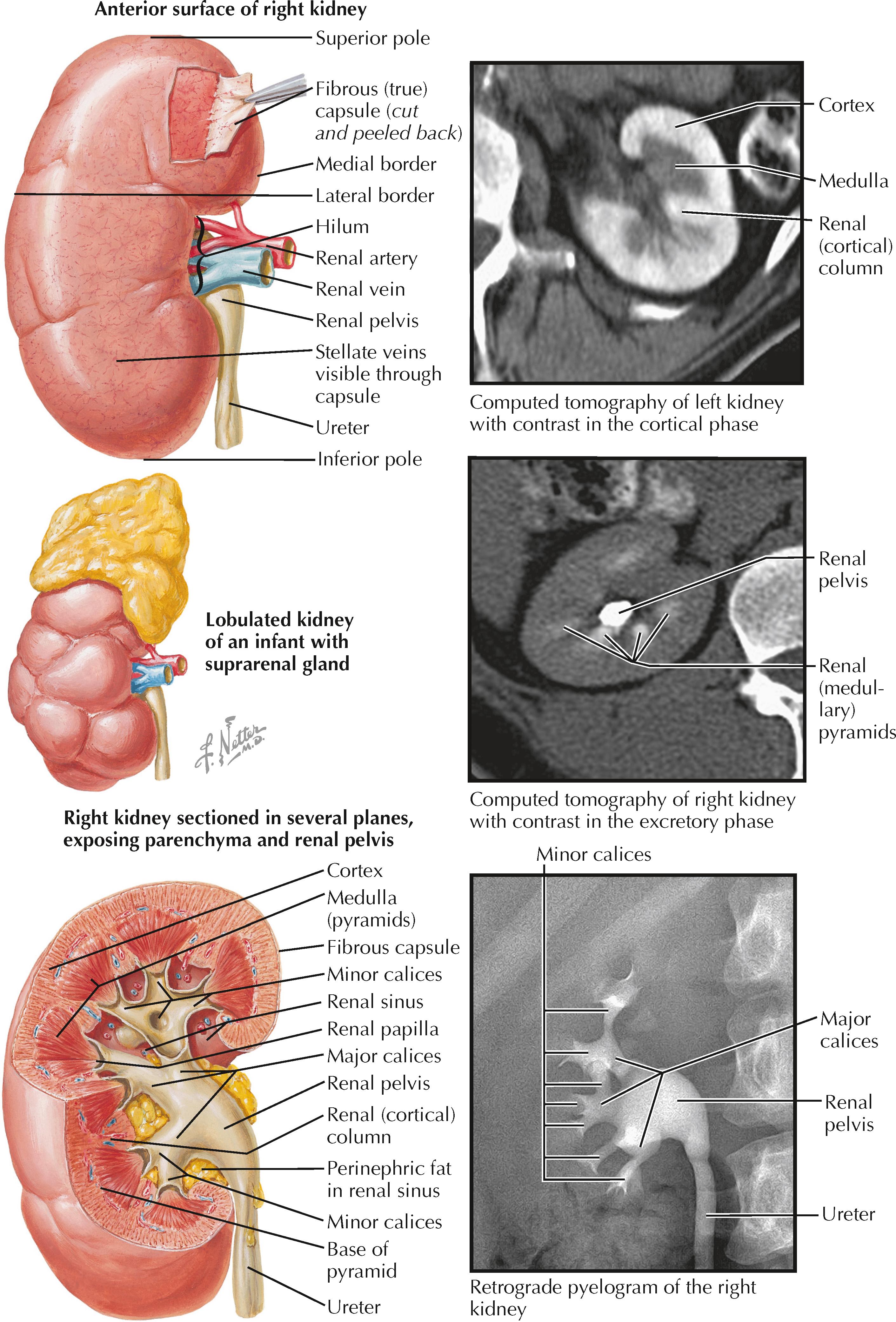
The parenchyma served by a single papilla is known as a renal lobe, and in the fetus and infant these lobes are evident as grossly visible convexities separated by deep grooves on the kidney surface. Such lobulation persists in some mammalian species throughout life, and vestigial demarcations of lobulation are occasionally present in the human adult.
The renal parenchyma is enclosed by a thin but distinct glistening membrane known as the fibrous (true) capsule of the kidney, which extends into the renal sinus. Immediately surrounding the fibrous capsule is a variable amount of perinephric fat (perirenal fat capsule), which forms a matrix around the structures within the renal sinus. The perinephric fat also surrounds the ipsilateral suprarenal gland.
The kidneys, suprarenal glands, and perinephric fat are all contained within a condensed, membranous layer of renal fascia. The renal fascia consists of a stronger posterior and more delicate anterior layer, previously described as two separate structures (posterior fascia of Zuckerkandl and anterior fascia of Gerota) that fused laterally to form the lateral conal fascia. At present, however, the renal fascia is regarded as a single structure.
The posterior layer originates from the lateral aspect of the psoas fascia, fusing variably with the anterior layer of thoracolumbar fascia (quadratus lumborum fascia) and transversalis fascia as it passes posterior and lateral to the kidney. It then wraps around the anterior aspect of the kidneys as the anterior layer. The medial continuation of the anterior layer ensheaths the renal vessels and fuses with the sheaths of the abdominal aorta and inferior vena cava. In some individuals, these fusions are very delicate and may rupture under pressure, permitting midline crossing of accumulated fluid. Another delicate fascial prolongation extends inferomedially along each ureter as periureteric fascia.
There is substantial disagreement over the craniocaudal boundaries of the renal fascia, reflecting its tenuous and elusive structure. In their cranial aspect, the anterior and posterior layers are generally thought to fuse superior to the suprarenal glands. In several studies this fused fascia appears to define a closed space on each side, which is then continuous with the diaphragmatic fascia in the region of the coronary ligament on the right and the gastrophrenic ligament on the left. Other studies, however, have challenged the notion that these spaces are closed, finding the perinephric space to be continuous with the bare area between liver and diaphragm on the right and the subphrenic extraperitoneal space on the left.
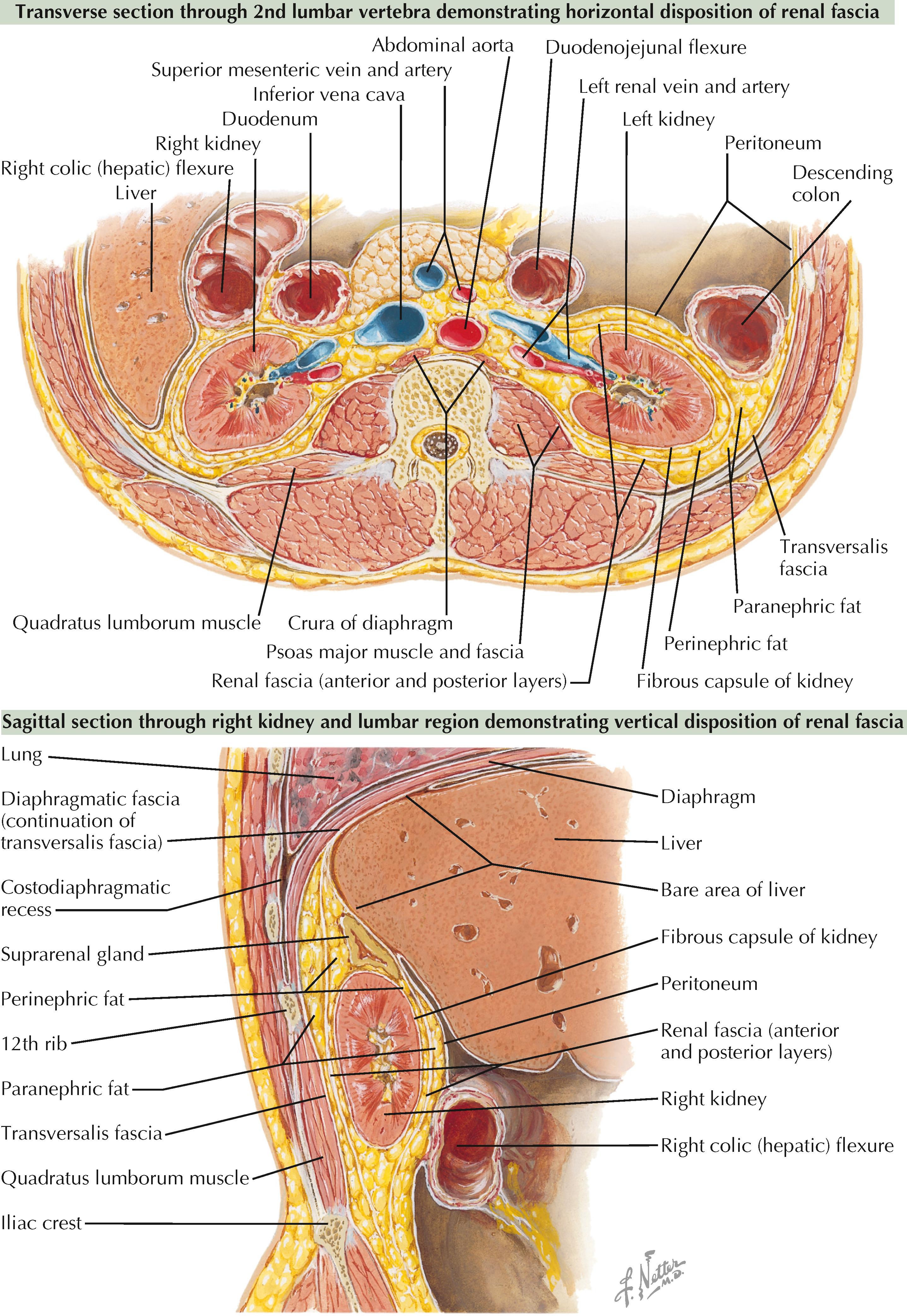
Caudally, fusion of the anterior and posterior layers is incomplete, which allows perinephric fluid to seep into the iliac fossa of the greater pelvis. Likewise, air injected into the presacral space is known to reach the perinephric space through this same opening; this technique was formerly used to visualize the kidneys in a procedure known as retroperitoneal pneumography.
External to the renal fascia lies the retroperitoneal paranephric fat (pararenal fat body), a continuation of the extraperitoneal fat. The perinephric and paranephric fat are both traversed by variably developed strands of collagenous connective tissue that extend from the renal fascia, which may cause them to appear multilaminate in sectional studies.
The ureters are paired muscular ducts that convey urine from the kidneys to the bladder. Each ureter begins medial to the ipsilateral kidney as a continuation of the renal pelvis and ends upon insertion into the posterior bladder wall. The ureters are retroperitoneal for their entire length, which is approximately 30 cm.
The ureters vary in diameter from 2 to 8 mm, increasing in size in the lower lumbar area. They are generally narrowest at their origin from the renal pelvis, at the crossing of the pelvic rim, and at their termination as they traverse the bladder wall. As a result, renal stones (see Plate 6-3 ) most often become impacted within or proximal to these three sites.
As the ureters exit the kidneys, they pass anterior to the psoas muscles and genitofemoral nerves. In addition, the right ureter lies posterior to the second (descending) part of the duodenum. More inferiorly, near their entry into the greater (false) pelvis, both ureters pass posterior to the gonadal vessels.
The ureters also cross the unpaired vessels supplying the intestines. The left ureter passes posterior to the left colic and sigmoid vessels, while the right ureter passes posterior to the right colic, ileocolic, and terminal superior mesenteric vessels. These vessels are contained within the fusion fascia formed as the ascending and descending portions of the colon became secondarily retroperitoneal. Thus they do not have ureteric branches and can be easily mobilized along with the colon to access the ureters.
As the ureters enter the lesser (true) pelvis, they pass anterior to the sacroiliac joint and common iliac vessels.
The ureters enter the lesser pelvis anterior to the internal iliac arteries. As they descend along the posterolateral pelvic wall, they run medial to the obturator vessels/nerves and the superior vesical (umbilical) arteries. At the level of the ischial spines, the ureters turn medially alongside branches of the hypogastric bundle of nerves (see Plate 1-14 ). The other anatomic relationships in the pelvic region differ between the two genders.
Just before the entering the bladder, each ureter passes inferior to the ipsilateral ductus (vas) deferens. At this point the ureters lie superior and anterior to the seminal glands (vesicles).
As the ureters descend along the lateral walls of the lesser (true) pelvis, they course posterior and then parallel to the ovarian vessels contained in the suspensory ligaments of the ovary. The ureters pass medial to the origins of the uterine arteries from the internal iliac arteries. As the ureters turn anteromedially from the pelvic wall, they run anterior and parallel to the uterosacral fold, posterior and inferior to the ovaries. As they traverse the base of the broad ligament, about 1.5 cm lateral to the uterine cervix, the ureters pass inferior to the uterine arteries as the arteries course medially toward the uterus.
The ureters penetrate the thick wall of the bladder about 2.5 cm from the midline. They run in an anteromedial direction within the wall of the bladder and then terminate at the ureteric orifices, which are 2 cm apart in the nondistended bladder. As intravesicular pressure increases, the intramural portions of the ureters become compressed, preventing reflux of urine. In this distended state, the ureteric orifices spread to become 5 cm apart.
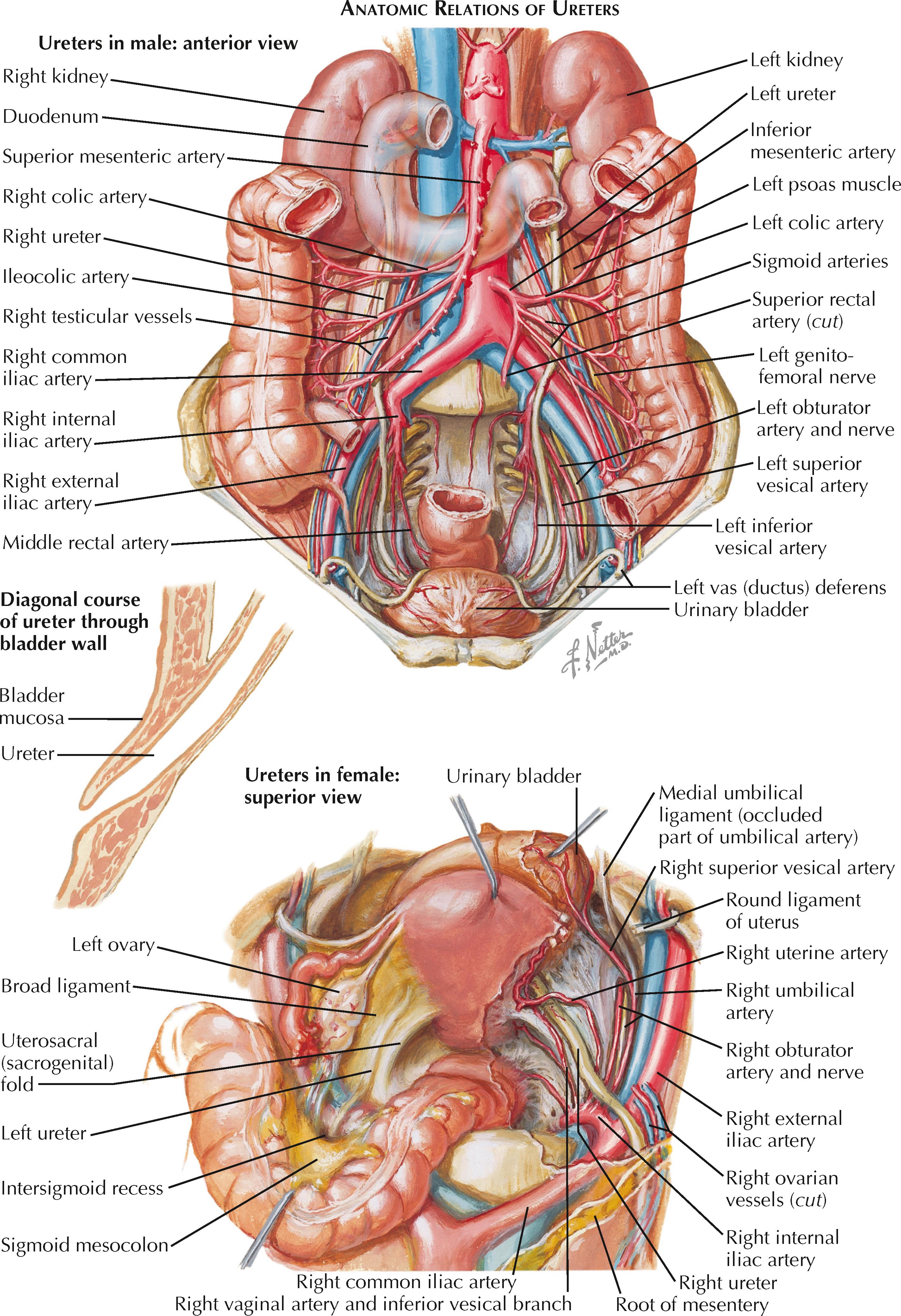
The urinary bladder is an expandable reservoir that receives urine from the ureters. When empty, the bladder lies entirely within the lesser pelvis and resembles a flattened, four-sided pyramid with rounded edges. The apex, which corresponds to the tip of the pyramid, is directed anteriorly. Opposite the apex is the base (fundus), the expansive posterior surface. Between the apex and fundus is the body of the bladder, which has a single superior surface, as well as two convex inferolateral surfaces separated by a rounded inferior edge. The bladder's most inferior and most fixed aspect is known as the neck. It is located just proximal to the outlet, also known as the internal urethral orifice.
The bladder wall consists of a loose, outer connective tissue layer, known as the vesical fascia; a three-layered muscularis propria of smooth muscle, known as the detrusor; and an internal mucosa. The ureters enter the bladder on its posteroinferior surface and then take an oblique course through its wall before terminating at the ureteric orifices. The two ureteric orifices, combined with the internal urethral orifice, bound an internal triangular region known as the trigone.
The anterior portion of the bladder rests on the pubic symphysis and adjacent bodies of the pubic bones; when empty, the bladder rarely extends beyond their superior margin. Between the pubic bones/symphysis and the bladder is the retropubic (prevesical) space (of Retzius), which contains a matrix of loose areolar tissue encasing the anterior portions of the vesical and prostatic venous plexuses. This space facilitates extraperitoneal access to the bladder and prostate via suprapubic abdominal incision.
As the bladder fills with urine, the body expands, causing its anterosuperior aspect to ascend into the extraperitoneal space superior to the pubic crest. The base and neck of the bladder, in contrast, remain relatively constant in both shape and position.
The apex of the empty bladder sends a solid, slender projection known as the median umbilical ligament superiorly along the midline of the abdominal wall, toward the umbilicus. This ligament represents a vestige of the urachus (see Plate 2-33 ) and rarely possesses a residual allantoic lumen. If a lumen is present, it infrequently may communicate with that of the bladder, but a urachus that is patent from bladder to the umbilicus is very rare.
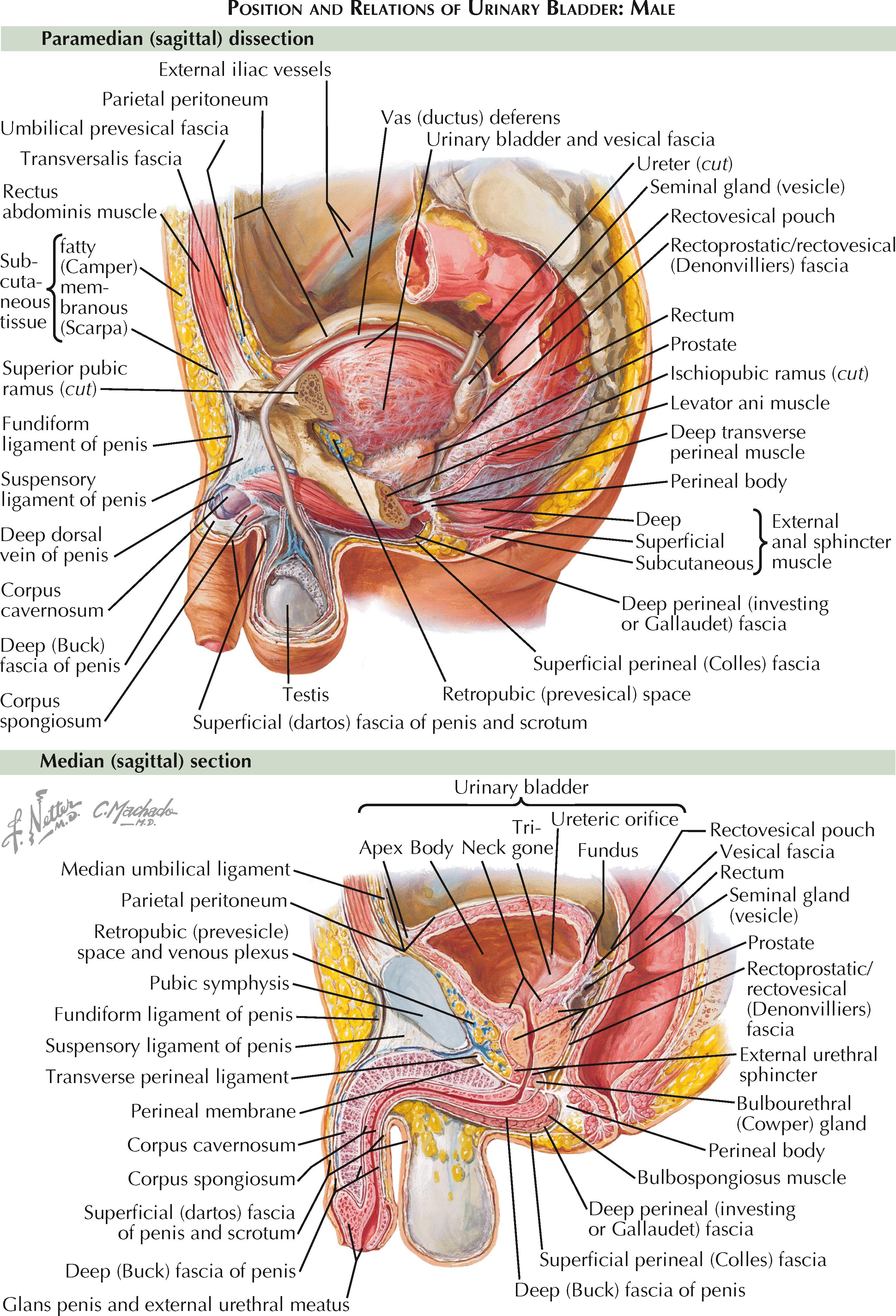
The peritoneum covering the anterosuperior aspect of the bladder reflects onto the abdominal wall to form the paired supravesical fossae of the peritoneal cavity. These fossae are divided by the median umbilical ligament and bounded laterally by the obliterated umbilical arteries, which form the medial umbilical ligaments. The level of the supravesical fossae (and consequently, the superior extent of the retropubic space) changes with bladder emptying and filling.
The walls of the bladder are covered by peritoneum to the level of the umbilical artery/medial umbilical ligament. The reflection of the peritoneum from the lateral walls of the bladder onto the lateral pelvic walls forms the shallow paravesical fossae of the peritoneal cavity. These fossae extend posteriorly to the vasa deferentia in males. In females, they extend to the anterior aspect of the broad ligament, which conveys the round ligaments of the uterus. Inferior to the paravesical fossae, the loose areolar tissue of the retropubic space continues laterally.
In the male, the two seminal glands (vesicles) and ampullae of the vasa deferentia lie between the base of the bladder and the rectum on each side of the midline. These structures are separated from the rectum by the rectoprostatic (rectovesical) fascia cor septum (also known as Denonvilliers fascia). This fascia is continuous with the tough envelopes of the ampullae of the vasa deferentia and seminal glands (vesicles), and it continues posterior to the prostate until it reaches the perineal body.
In the female, the urethra and bladder are separated from the vagina and cervix by the vesicovaginal fascia, which normally contains a small amount of areolar tissue. The vesicovaginal fascia, as well as the rectovaginal fascia (or septum, located posterior to the vagina), together are homologous to the male rectoprostatic (rectovesical) fascia.
In males, the rectoprostatic (rectovesical) fascia is located inferior to the rectovesical pouch, the inferior-most extent of the peritoneal cavity. In the fetus, this pouch is a deeper excavation, which dips posterior to the prostate as far as the pelvic floor. In females, the rectovaginal fascia is directly inferior to a similar space, termed the recto-uterine pouch (cul-de-sac of Douglas).
In the male, the peritoneum extends from the bladder around each side of the rectum toward the sacrum as a pair of sickle-shaped shelves called the sacrogenital (vesicosacral) folds, bounding the pararectal fossae. In the female, the sacrogenital (uterosacral) folds arise from the dorsolateral walls of the uterine cervix (see Plate 1-6 ). At the base of the bladder, these folds contain the terminal portions of the ureters and, in the male, the ductus deferens.
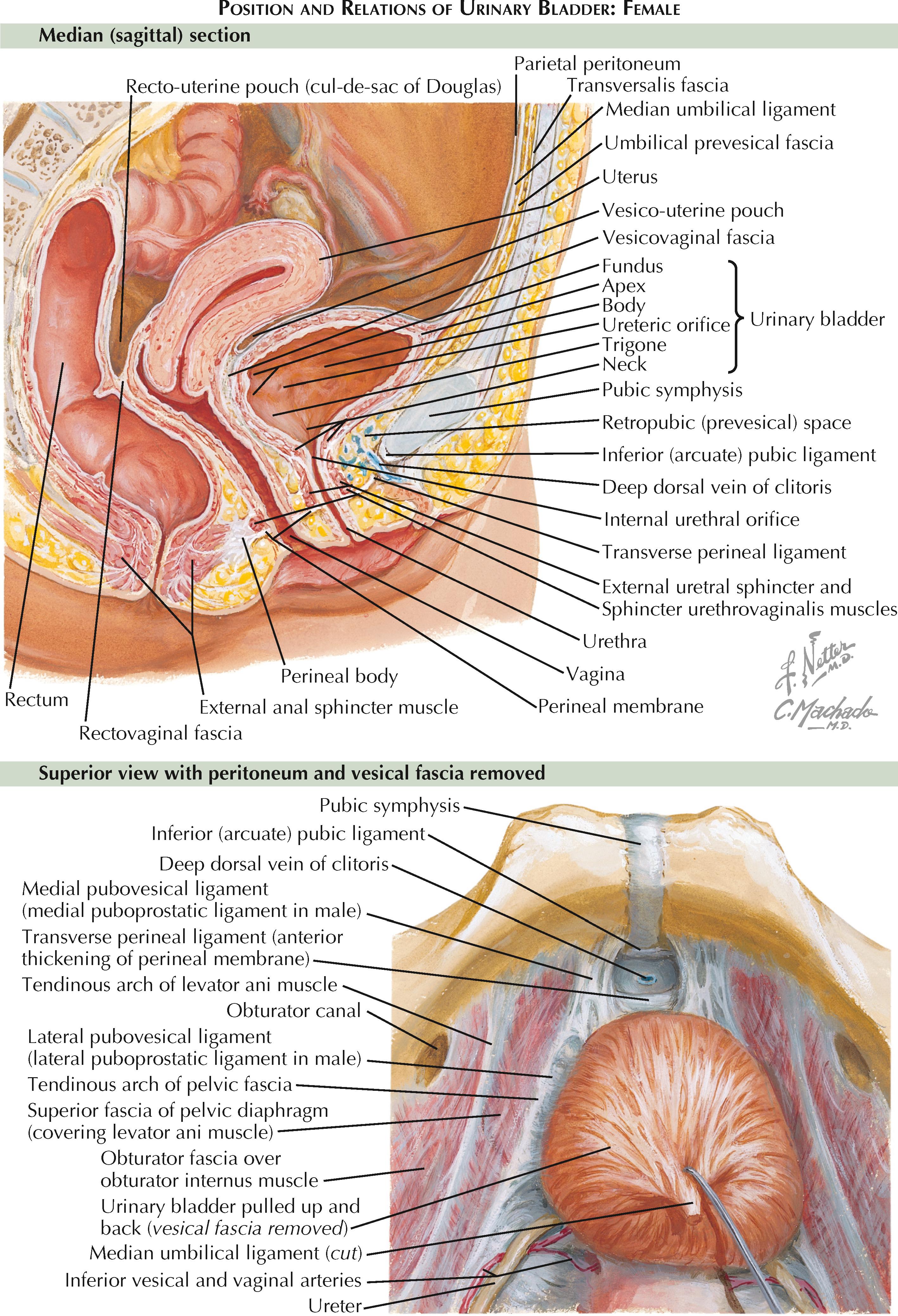
Except for a variable layer of endopelvic fascia, the neck of the bladder rests directly on the pelvic floor muscles (e.g., levator ani) in females, whereas in males the prostate gland is interposed between them. In the male, the internal urethral orifice lies about 1 or 2 cm superior to, and 2 cm posterior to, the subpubic angle. In the female, the position of the urethral orifice is slightly more inferior. In the newborn, the bladder is more abdominal than pelvic in position, and the urethral orifice may be situated as far superiorly as the pubic crest.
The inferior, subperitoneal aspect of the bladder is connected to the pubis by two ligaments originating in the prostatic fascia in males and vesical fascia in females.
The first of these ligaments is known as the medial puboprostatic ligament in males and the medial pubovesical ligament in females. This ligament lies close to the pelvic floor and flanks the deep dorsal vein of the penis (or clitoris) as it pierces up the pelvic floor to enter the prostatic (or vesical) venous plexus. Other ligaments flanking this vein include the inferior (arcuate) pubic ligament anteriorly, which forms the inferior margin of the pubic symphysis, and the transverse perineal ligament posteriorly, which is an anterior thickening of the perineal membrane.
The second ligament is known as the lateral puboprostatic ligament in males and the lateral pubovesical ligament in females. This ligament is formed by a lateral extension of the prostatic (or, in females, vesical) fascia over the inferior group of vesical arteries, pudendal veins (draining the vesical plexus), and autonomic nerves. The terminal part of the ureter and (in males) vas deferens contribute adventitia to this ligament. At its lateral edge, this ligament joins the superior fascia of the pelvic diaphragm, which invests the levator ani. This linear area of attachment is known as the tendinous arch of the pelvic fascia.
The detrusor muscle, which contracts under parasympathetic stimulation, consists of three layers of muscle. Unlike in the gastrointestinal tract, however, these muscle layers are not clearly distinct in all areas.
The outer muscle layer consists of predominantly longitudinal fibers, which are especially numerous in the midline region and near the neck. The thin middle muscle layer encircles the fundus and body. In males, additional circular fibers create the internal urethral sphincter in the inferior neck, which contracts during sympathetically stimulated ejaculation to prevent reflux of semen into the bladder.
The innermost layer of the detrusor contains additional longitudinal fibers. In the region of the trigone, this layer is intimately attached to the mucosa and forms the trigonal muscle.
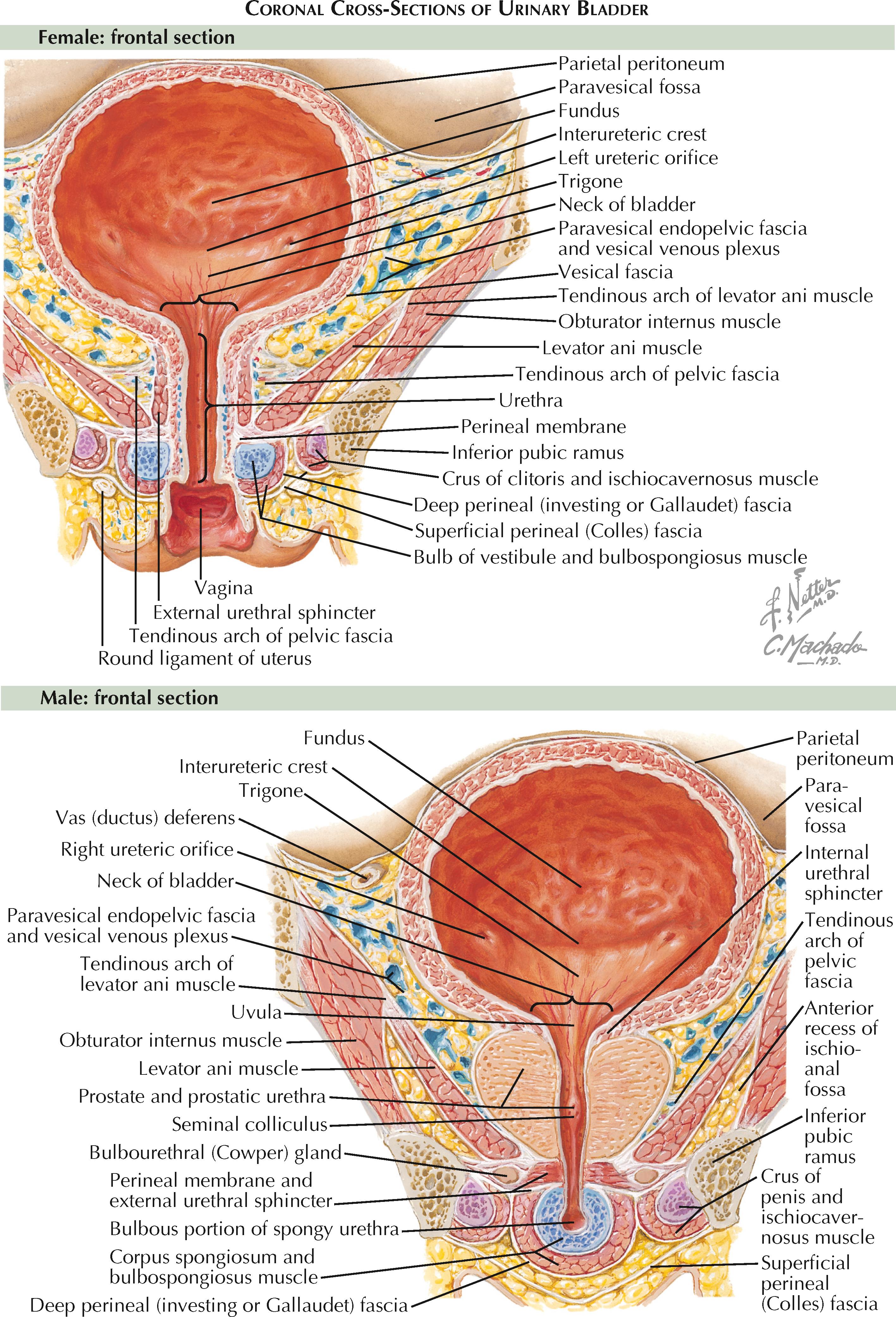
Around the ureteric orifices, the muscular coat of each ureter also fans out into the bladder. Some of these muscle fibers cross the midline to unite with strands from the opposite side, raising an interureteric crest.
The sides of the trigone are outlined by yet another group of submucosal fibers, known as Bell muscle, which connect the ureteral muscles with the wall of the urethra. Tension across these bands, especially when combined with pressure from the neighboring middle lobe of the prostate (in males), leads to a small elevation above the bladder neck known as the uvula.
The innermost layer of the bladder is the mucosa. When the bladder is empty, the mucosa is corrugated by numerous folds. As the bladder distends, however, the folds are obliterated. The mucosa of the trigone is anatomically distinct, however, because it is firmly attached to the muscularis, consequently appearing smooth even when the bladder is empty.
At rest, 20% to 25% of the cardiac output circulates through the kidneys. Accordingly, the renal arteries are major paired branches of the abdominal aorta. These arteries arise from the abdominal aorta roughly at the level of the L1/L2 intervertebral disc, about 1 cm inferior to the origin of the superior mesenteric artery.
Because the aorta is slightly to the left of the midline here, the left renal artery is shorter than the right. It takes a nearly horizontal course to the left kidney.
Because the right kidney is positioned slightly inferior to the left kidney, the right renal artery arises either inferior to the origin of the left or, more frequently, takes an oblique path. During its course, the right renal artery passes posterior to the inferior vena cava.
Both renal arteries run posterior and slightly cranial to the corresponding renal veins. The arteries are surrounded by a dense plexus of nerve fibers that arrive by way of the celiac, superior mesenteric, and aorticorenal ganglia, located adjacent to the origins of the celiac, superior mesenteric, and renal arteries.
On the left, the body of the pancreas lies anterior or slightly superior to the left renal artery, with the splenic vein between them. The inferior mesenteric vein may or may not be in close relationship with the left renal vessels, depending on where it joins the splenic vein.
On the right, the duodenum and the head of the pancreas are adherent to the anterior surface of the right renal artery (see Plate 1-1 for a picture of these relationships).
On the left, the left diaphragmatic crus, psoas muscle, ascending lumbar vein (the lateral root of the hemiazygos vein), and sympathetic trunk lie posterior to the renal artery.
On the right, the azygos vein, right lumbar lymphatic trunk, and right crus of the diaphragm lie posterior to the proximal section of the renal artery. The psoas muscle lies posterior to the middle section of the renal artery.
Become a Clinical Tree membership for Full access and enjoy Unlimited articles
If you are a member. Log in here